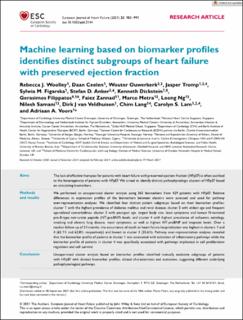| dc.contributor.author | Woolley, Rebecca J. | |
| dc.contributor.author | Ceelen, Daan | |
| dc.contributor.author | Ouwerkerk, Wouter | |
| dc.contributor.author | Tromp, Jasper | |
| dc.contributor.author | Figarska, Sylwia M. | |
| dc.contributor.author | Anker, Stefan D. | |
| dc.contributor.author | Dickstein, Kenneth | |
| dc.contributor.author | Filippatos, Gerasimos | |
| dc.contributor.author | Zannad, Faiez | |
| dc.contributor.author | Marco, Metra | |
| dc.contributor.author | Ng, Leong L. | |
| dc.contributor.author | Samani, Nilesh J. | |
| dc.contributor.author | van Veldhuisen, Dirk J | |
| dc.contributor.author | Lang, Chim C. | |
| dc.contributor.author | Lam, Carolyn S.P. | |
| dc.contributor.author | Voors, Adriaan A. | |
| dc.date.accessioned | 2022-04-20T08:54:44Z | |
| dc.date.available | 2022-04-20T08:54:44Z | |
| dc.date.created | 2021-09-02T18:48:16Z | |
| dc.date.issued | 2021 | |
| dc.identifier.issn | 1388-9842 | |
| dc.identifier.uri | https://hdl.handle.net/11250/2991539 | |
| dc.description.abstract | Aims
The lack of effective therapies for patients with heart failure with preserved ejection fraction (HFpEF) is often ascribed to the heterogeneity of patients with HFpEF. We aimed to identify distinct pathophysiologic clusters of HFpEF based on circulating biomarkers.
Methods and results
We performed an unsupervised cluster analysis using 363 biomarkers from 429 patients with HFpEF. Relative differences in expression profiles of the biomarkers between clusters were assessed and used for pathway over-representation analyses. We identified four distinct patient subgroups based on their biomarker profiles: cluster 1 with the highest prevalence of diabetes mellitus and renal disease; cluster 2 with oldest age and frequent age-related comorbidities; cluster 3 with youngest age, largest body size, least symptoms and lowest N-terminal pro-B-type natriuretic peptide (NT-proBNP) levels; and cluster 4 with highest prevalence of ischaemic aetiology, smoking and chronic lung disease, most symptoms, as well as highest NT-proBNP and troponin levels. Over a median follow-up of 21 months, the occurrence of death or heart failure hospitalization was highest in clusters 1 and 4 (62.1% and 62.8%, respectively) and lowest in cluster 3 (25.6%). Pathway over-representation analyses revealed that the biomarker profile of patients in cluster 1 was associated with activation of inflammatory pathways while the biomarker profile of patients in cluster 4 was specifically associated with pathways implicated in cell proliferation regulation and cell survival.
Conclusion
Unsupervised cluster analysis based on biomarker profiles identified mutually exclusive subgroups of patients with HFpEF with distinct biomarker profiles, clinical characteristics and outcomes, suggesting different underlying pathophysiological pathways. | en_US |
| dc.language.iso | eng | en_US |
| dc.publisher | Wiley | en_US |
| dc.rights | Navngivelse-Ikkekommersiell 4.0 Internasjonal | * |
| dc.rights.uri | http://creativecommons.org/licenses/by-nc/4.0/deed.no | * |
| dc.title | Machine learning based on biomarker profiles identifies distinct subgroups of heart failure with preserved ejection fraction | en_US |
| dc.type | Journal article | en_US |
| dc.type | Peer reviewed | en_US |
| dc.description.version | publishedVersion | en_US |
| dc.rights.holder | Copyright 2021 The Author(s) | en_US |
| cristin.ispublished | true | |
| cristin.fulltext | original | |
| cristin.qualitycode | 2 | |
| dc.identifier.doi | 10.1002/ejhf.2144 | |
| dc.identifier.cristin | 1930959 | |
| dc.source.journal | European Journal of Heart Failure | en_US |
| dc.source.pagenumber | 983-991 | en_US |
| dc.identifier.citation | European Journal of Heart Failure. 2021, 23 (6), 983-991. | en_US |
| dc.source.volume | 23 | en_US |
| dc.source.issue | 6 | en_US |

